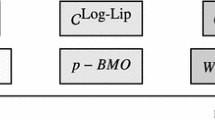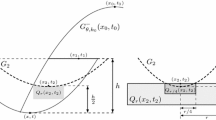Abstract
We obtain Schauder estimates for a class of concave fully nonlinear nonlocal parabolic equations of order \(\sigma \in (0,2)\) with rough and non-symmetric kernels. We also prove that the solution to a translation invariant equation with merely bounded data is \(C^\sigma \) in x variable and \(\Lambda ^1\) in t variable, where \(\Lambda ^1\) is the Zygmund space. From these results, we can derive the corresponding results for nonlocal elliptic equations with rough and non-symmetric kernels, which are new even in this case.
Similar content being viewed by others
References
Caffarelli, L., Silvestre, L.: Regularity theory for fully nonlinear integro-differential equations. Commun. Pure Appl. Math. 62(5), 597–638 (2009)
Caffarelli, L., Silvestre, L.: The Evans-Krylov theorem for nonlocal fully nonlinear equations. Ann. Math. 174(2), 1163–1187 (2011)
Caffarelli, L., Silvestre, L.: Regularity results for nonlocal equations by approximation. Arch. Ration. Mech. Anal. 200(1), 59–88 (2011)
Caffarelli, L.A., Cabré, X.: Fully Nonlinear Elliptic Equations, Volume 43 of American Mathematical Society Colloquium Publications. American Mathematical Society, Providence, RI (1995)
Lara, H.C., Dvila, G.: \(C^{\sigma,\alpha }\) estimates for concave, non-local parabolic equations with critical drift. J. Integral Equ. Appl. 28(3), 373–394 (2016)
Chang-Lara, H., Davila, G.: Hölder estimates for non-local parabolic equations with critical drift. J. Differ. Equ. 260(5), 4237–4284 (2016)
Chang-Lara, H., Dávila, G.: Regularity for solutions of non local parabolic equations. Calc. Var. Partial Differ. Equ. 49(1–2), 139–172 (2014)
Chang-Lara, H., Dávila, G.: Regularity for solutions of nonlocal parabolic equations II. J. Differ. Equ. 256(1), 130–156 (2014)
Chang-Lara, H.A., Kriventsov, D.: Further time regularity for non-local, fully non-linear parabolic equations. Commun. Pure Appl. Math. https://doi.org/10.1002/cpa.21671
Cont, R., Tankov, P.: Financial Modelling with Jump Processes. Chapman & Hall/CRC Financial Mathematics Series. Chapman & Hall/CRC, Boca Raton, FL (2004)
Dong, H., Kim, D.: On \(L_p\)-estimates for a class of non-local elliptic equations. J. Funct. Anal. 262(3), 1166–1199 (2012)
Dong, H., Kim, D.: Schauder estimates for a class of non-local elliptic equations. Discrete Contin. Dyn. Syst. 33(6), 2319–2347 (2013)
Evans, L.C.: Classical solutions of fully nonlinear, convex, second-order elliptic equations. Commun. Pure Appl. Math. 35(3), 333–363 (1982)
Gilbarg, D., Trudinger, N.S.: Elliptic Partial Differential Equations of Second Order. Classics in Mathematics. Springer, Berlin (2001). Reprint of the 1998 edition
Tianling, J., Jingang, X.: Schauder estimates for nonlocal fully nonlinear equations. Ann. Inst. H. Poincaré Anal. Non Linéaire 33(5), 1375–1407 (2016)
Jin, T., Xiong, J.: Schauder estimates for solutions of linear parabolic integro-differential equations. Discrete Contin. Dyn. Syst. 35(12), 5977–5998 (2015)
Komatsu, T.: Pseudodifferential operators and Markov processes. J. Math. Soc. Jpn. 36(3), 387–418 (1984)
Krylov, N.V.: Boundedly inhomogeneous elliptic and parabolic equations in a domain. Izv. Akad. Nauk SSSR Ser. Mat. 47(1), 75–108 (1983)
Krylov, N.V.: Lectures on Elliptic and Parabolic Equations in Hölder Spaces, Volume 12 of Graduate Studies in Mathematics. American Mathematical Society, Providence, RI (1996)
Mikulevičius, R., Pragarauskas, H.: On the Cauchy problem for certain integro-differential operators in Sobolev and Hölder spaces. Liet. Mat. Rink. 32(2), 299–331 (1992)
Mikulevicius, R., Pragarauskas, H.: On the Cauchy problem for integro-differential operators in Hölder classes and the uniqueness of the martingale problem. Potential Anal. 40(4), 539–563 (2014)
Mou, C.: Interior regularity for nonlocal fully nonlinear equations with Dini continuous terms. J. Differ. Equ. 260(11), 7892–7922 (2016)
Safonov, M.V.: Classical solution of second-order nonlinear elliptic equations. Izv. Akad. Nauk SSSR Ser. Mat. 52(6), 1272–1287, 1328 (1988)
Schwab, R.W., Silvestre, L.: Regularity for parabolic integro-differential equations with very irregular kernels. Anal. PDE 9(3), 727–772 (2016)
Serra, J.: Regularity for fully nonlinear nonlocal parabolic equations with rough kernels. Calc. Var. Partial Differ. Equ. 54(1), 615–629 (2015)
Serra, J.: \(C^{\sigma +\alpha }\) regularity for concave nonlocal fully nonlinear elliptic equations with rough kernels. Calc. Var. Partial Differ. Equ. 54(4), 3571–3601 (2015)
Acknowledgements
The authors would like to thank the referees for their careful review as well as many valuable comments and suggestions.
Author information
Authors and Affiliations
Corresponding author
Additional information
Communicated by O. Savin.
Publisher's Note
Springer Nature remains neutral with regard to jurisdictional claims in published maps and institutional affiliations.
H. Dong and H. Zhang were partially supported by the NSF under agreements DMS-1056737 and DMS-1600593.
Appendix
Appendix
In the “Appendix”, we first provide a sketch of the proof of Corollary 2.2.
Proof
By a scaling argument, we assume that \(r=1\). Let \(k\ge 1\) be a constant to be determined later. Set \({\hat{\delta }}=\delta /k\). Let \((t_0,x_0)\in \overline{Q_{\delta /2}}\) be such that \(u(t_0,x_0)=\inf _{Q_{\delta /2}}u\). Since \(\sigma \in (1,2)\), we have \(2^{-\sigma }\le 1-4^{-\sigma }\). By a scaling and translation of the coordinates, we apply Proposition 2.1 to u in \(Q_{{\hat{\delta }}}(t_0,x_0)\) and obtain
where \({\hat{Q}}_1=Q_{{\hat{\delta }}}(t_1,x_0)\) and \(t_1=t_0-(4^\sigma -1){{\hat{\delta }}}^\sigma \). For any \(x_1\in B_{{\hat{\delta }}/2}(x_0)\),
where \(C_2>0\) depending only on d. Therefore,
Applying Proposition 2.1 again, we have
where \({\hat{Q}}_2=Q_{{\hat{\delta }}}(t_2,x_1)\) and \(t_2=t_0-2(4^\sigma -1){{\hat{\delta }}}^\sigma \), and for any \(x_2\in B_{{{\hat{\delta }}}/2}(x_1)\),
By induction, or any \(x_{n-1}\in B_{(n-1){{\hat{\delta }}}/2}(x_0)\cap B_1\),
where \({\hat{Q}}_n=Q_{{\hat{\delta }}}(t_{n},x_{n-1})\), \(t_{n}=t_0-n(4^\sigma -1){\hat{\delta }}^\sigma \), and \(C_3\) is a constant depending only on \(\lambda \), \(\Lambda \), d, and n. Notice that \(|x_0|\le \delta /2\), \(t_0\in [-(\delta /2)^\sigma ,0]\), and \(\sigma >1\). We can choose \(k\ge 1\) in a suitable range depending only on \(\sigma _2\) and \(\delta \), and then \(n\le [2k/\delta ]+1\), such that \({{\hat{Q}}}_n\) runs through \((-\delta ^\sigma ,-\delta ^\sigma +(4^\sigma -1){\hat{\delta }}^\sigma )\times B_1\). Finally, by applying Proposition 2.1 again and using a simple covering argument, we prove the corollary. \(\square \)
Finally, we give the proofs of Lemmas 5.1, 5.2, and 5.3.
Proof of Lemma 5.1
By mollification, it suffices to prove (5.2) assuming that \(f\in C^\alpha ((-1,0))\). Let \(x,y\in (-1,0)\), \(y<x\), and \(h:=x-y\). When \(h\ge 1/3\),
When \(h<1/3\), either \(x<-1/3\) or \(y>-2/3\). If \(x<-1/3\), then \(2x-y\in (x,0)\) and
The case when \(y>-2/3\) is similar. Therefore,
which yields (5.2). \(\square \)
Proof of Lemma 5.2
First we consider the case when \(\beta =1\). Integrating by part and noting that \(\eta ''\) is an even function and \(\int \eta ''=0\), we obtain
For \(\beta \in (0,1)\), when \(r\ge R^\sigma \),
When \(r\in (0,R^\sigma )\), by (5.3) with \(\beta =1\),
From the above two inequalities, we immediately get (5.3). \(\square \)
Proof of Lemma 5.3
We first estimate the Hölder semi-norm in x. By the interpolation inequality,
Because p is linear,
Since \(\eta \) has unit integral, we have
Furthermore, for any \((t,x)\in (-R^\sigma ,0)\times B_{2^jR}\),
Using Lemma 5.2, we have
which together with (5.19) implies that
We plug (5.18) and (5.20) in (5.17) and get (5.4).
Next we estimate the Hölder semi-norm in t. Obviously,
From Lemma 5.1 and scaling, we have
We follow the proof of (5.20) to estimate
Therefore, we reach (5.5). The lemma is proved. \(\square \)
Proof of Lemma 5.4
We modify the proof of Lemma 5.3. Similar to Lemma 5.1, we have
Since \(\eta \) and \(\zeta \) have unit integral and \(\zeta \) is radial, we have
For any \((t,x)\in Q_{2^jR}\), similar to Lemma 5.2 with \(\beta =\alpha /2\),
which together with (5.22) implies that
We plug (5.23) in (5.21) and get (5.6). The lemma is proved. \(\square \)
Rights and permissions
About this article
Cite this article
Dong, H., Zhang, H. On Schauder estimates for a class of nonlocal fully nonlinear parabolic equations. Calc. Var. 58, 40 (2019). https://doi.org/10.1007/s00526-019-1482-7
Received:
Accepted:
Published:
DOI: https://doi.org/10.1007/s00526-019-1482-7




